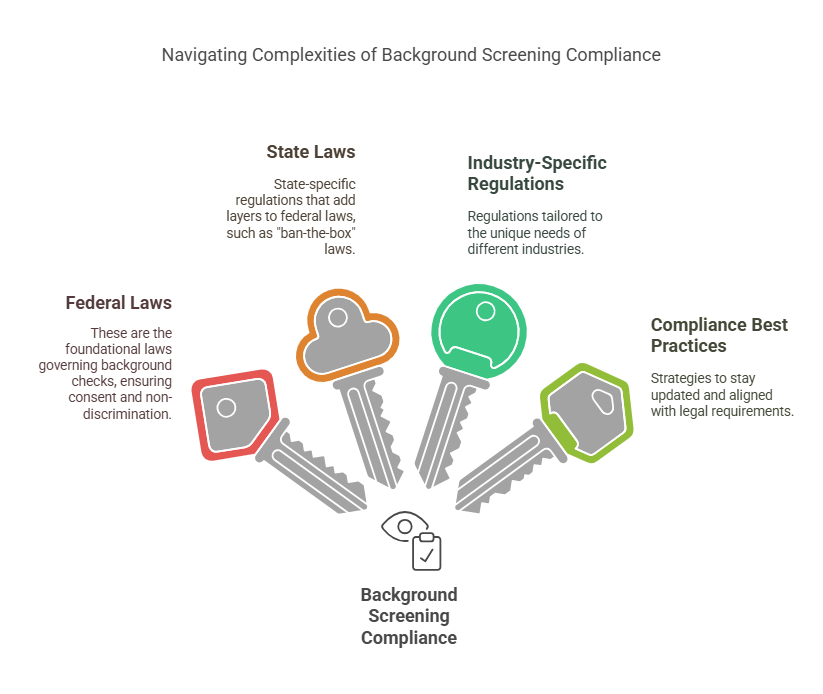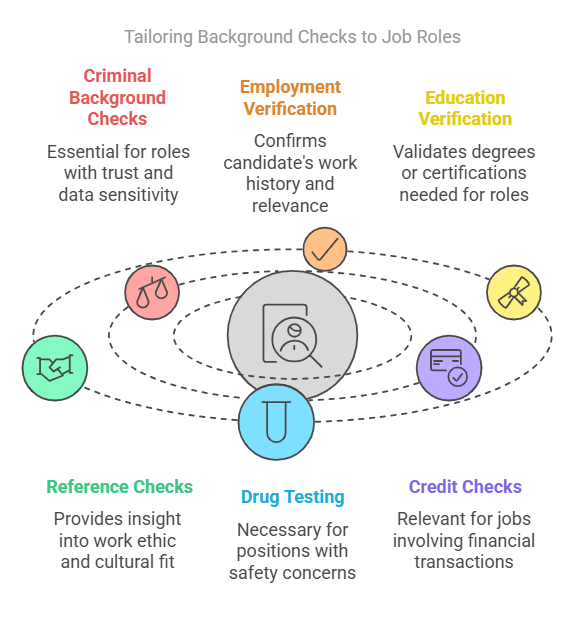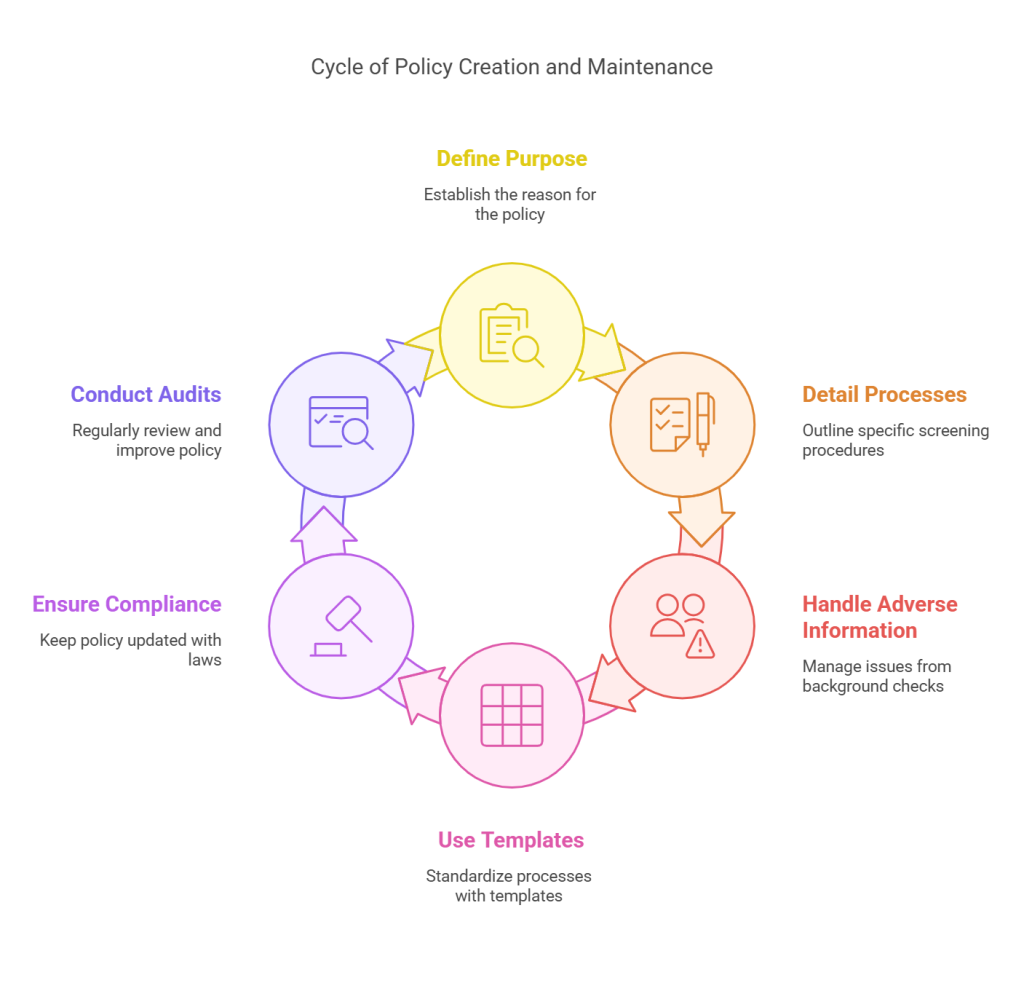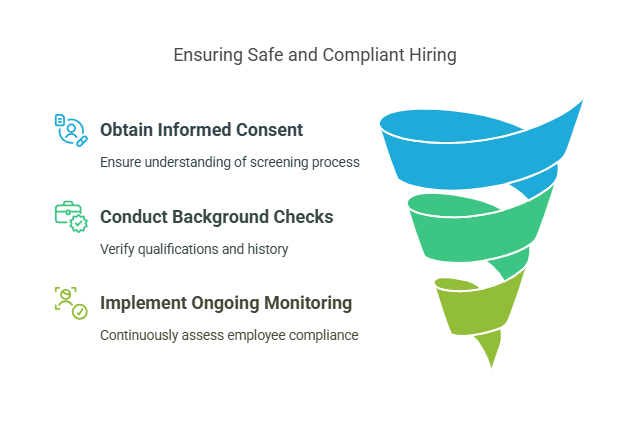Contingent workers, including temporary and contract workers, form an essential part of the modern workforce. As this population grows, so do the associated risks and challenges, highlighting the importance of robust background screening policies. This guide outlines the best practices for ensuring that staffing agencies and recruitment firms navigate the complex legal and practical landscape effectively.
Key Takeaways
- Effective background screening is essential for managing risks associated with hiring temporary and contract workers, ensuring legal compliance and workplace safety.
- Understanding federal, state, and industry-specific regulations, such as the FCRA and EEOC guidelines, is crucial to steer clear of legal troubles during the screening process.
- Crafting a comprehensive screening policy requires tailoring checks to job roles, maintaining detailed records, and integrating ongoing processes to adjust to legal changes.
- Selecting the right background screening provider involves ensuring accreditation, data security, and timely, cost-effective service that aligns with your company’s hiring needs.
- Address challenges like rapid hiring and high turnover through streamlined processes and continuous monitoring to maintain an effective and compliant temporary workforce.
Introduction
If you’ve ever managed a team, you know the demand for temporary and contract workers is growing. These contingent workers are essential, but they bring unique challenges. Background screening is critical in managing these challenges.
Why focus on background checks? They protect your business from hiring risks. They help you avoid potential legal issues. And they maintain a safe work environment.
This article will share insights from 20 years in the field. You’ll learn about legal requirements, best practices, and practical steps. Are your policies comprehensive enough? What should you look for in a screening provider?
Let's start by exploring the legal landscape, and then we’ll move into creating and implementing effective policies.
EXPERT INSIGHT: When hiring contingent, gig, or contractual employees, leaders often opt for the most basic background check, or sometimes none at all. This is because contractual employees typically stay for a brief period, often just a season or two. The rationale is simple: why spend the extra money? However, hiring the wrong person can have significant consequences, even within a short time frame. In just a few hours to a few days, an unsuitable hire can create havoc, posing dangers to co-workers and tarnishing the firm's reputation. According to a study by CareerBuilder, 74% of employers report having hired the wrong person for a position, and the consequences have been costly. So think about it. Investing in thorough background checks can mitigate risks and promote a safer work environment. Read on to get more ideas. - Emile Garcia, SHRM-SCP, CHRP, CHRBP
Understanding the Legal Landscape
When it comes to background checks for temporary and contract workers, the legal landscape can be tricky. Understanding federal, state, and industry-specific regulations is essential.
Federal Laws
- Fair Credit Reporting Act (FCRA): This federal law is fundamental for using consumer reports responsibly. You need to obtain a job candidate's written consent before conducting a background check. If you plan to take adverse action based on the report, such as not hiring the candidate, you must follow specific procedures. These include providing a pre-adverse action notice, a copy of the report, and a summary of rights under the FCRA.
- Equal Employment Opportunity Commission (EEOC) Guidance: The EEOC provides guidelines to help prevent discrimination in hiring practices. When using background checks, you must avoid policies that disproportionately affect certain groups unless they are job-related and necessary. Consider if your screening policies unintentionally disadvantage certain demographics. This could lead to a "disparate impact," where your process appears neutral but leads to discrimination.
The federal legal framework shapes how you conduct background checks. Understanding these laws is crucial to avoid legal pitfalls. Have you reviewed your screening processes lately to ensure they align with these federal requirements?
State Laws
State laws on background checks can vary significantly and pose unique challenges for staffing agencies. One key area of variation is the so-called "ban-the-box" laws. These regulations prohibit employers from asking about criminal history on initial job applications. Their aim is to reduce employment barriers for individuals with prior convictions. They are becoming more common across the United States but differ in application and scope.
For example, California's Fair Chance Act requires employers to delay background checks until after a conditional job offer is made. This law also demands a fair assessment when a criminal record is found. On the other hand, states like Georgia have less restrictive policies, applying "ban-the-box" only to public sector jobs. Understanding these differences is crucial for compliance.
Another variation among states involves restrictions on the type of information that can be considered. Some states, like New York, limit the use of arrest records and require relevance tests for considering convictions. Massachusetts goes a step further, prohibiting most employers from considering misdemeanors older than five years.
For staffing agencies, navigating these differences can be tricky. Agencies operating in multiple states need adaptable policies to stay compliant. Regular reviews of state-specific regulations are essential to avoid legal pitfalls.
Have you adjusted your policies to align with these state-specific requirements? Engaging with a knowledgeable legal advisor can provide clarity and ensure your agency’s screening practices are legally sound. State laws around background checks are ever-evolving. Staying informed is not just wise; it's necessary for compliance.

Industry-Specific Regulations
Different industries come with unique regulatory demands when it comes to background screening for temporary and contract workers. These regulations ensure that workers meet specific standards pertinent to each field.
In healthcare, for example, background checks often extend beyond basic criminal history. You’ll find requirements for license verification, ensuring that healthcare professionals hold valid and current credentials. This is critical to patient safety and compliance with regulatory bodies like the Joint Commission.
For the finance industry, regulations focus on maintaining integrity and security. Institutions must comply with stringent checks, including credit history and detailed criminal background checks, to protect sensitive financial data. The Gramm-Leach-Bliley Act highlights specific requirements to safeguard consumer information against the backdrop of increasing financial crimes.
Transportation is another sector with rigorous screening demands. The Department of Transportation mandates that employers check driving records and conduct regular drug tests. Ensuring drivers meet safety standards is a priority to reduce risks on the road.
Have you considered how your industry’s specific regulations affect your hiring practices? By meeting these standards, you not only minimize liability but also foster trust among your clients and customers. Staying informed and compliant can save you from potential legal repercussions and enhance your organization’s reputation.
Compliance Best Practices
Staying ahead of legal changes is crucial. Laws change rapidly, and what works today might be outdated tomorrow. Keep track of federal, state, and industry-specific regulations. Maintain a schedule to review updates regularly. Use tools, newsletters, or legal software to stay informed.
Getting legal advice is smart. A legal expert can help you interpret complex laws. They provide insights into gray areas, ensuring your practices align with current regulations. It’s an investment in avoiding costly mistakes.
Use documented procedures to ensure consistent compliance. Develop checklists or flowcharts that guide your team. This way, processes remain consistent, transparent, and easy to follow.
Training is essential. Educate your staff about current laws and updates. Regular workshops or briefings can highlight key changes, keeping everyone on the same page.
Data protection should be a priority. Implement strict protocols to secure sensitive information. Regular audits can help identify vulnerabilities, protecting against data breaches.
Constant oversight is vital. Monitor your compliance strategies regularly. Revise and update them as needed. This proactive approach reduces risk and helps manage any legal pitfalls effectively.
Developing a Comprehensive Background Screening Policy
When crafting a background screening policy for temporary and contract workers, specificity is critical. Begin by clearly defining the scope of screening. Different roles carry different risks, so tailor the types of checks to the duties and responsibilities of each position. For some, a criminal history check might suffice, while others may require employment and education verification, reference checks, drug testing, or credit checks.
It's not just about what you check—it's about having a written policy to guide the process. Create a template or checklist outlining the purpose of the checks, the specific types of checks conducted, how you'll obtain consent, and how you plan to handle adverse findings. Ensure that these processes align with FCRA and EEOC guidelines to maintain compliance.
Implementation is another cornerstone. Consistency in applying your policy across all hires is non-negotiable. Train your team thoroughly on the policy to ensure everyone is on the same page. Documentation practices should be rigorous, with detailed records kept of all screening activities, findings, and decisions.
Remember: a background screening policy isn't static. It should evolve with legal changes and the needs of your organization. Regular reviews are essential to stay compliant and effective.
Defining the Scope of Screening
When creating a background screening policy, start by understanding what types of checks are necessary. You can't apply a one-size-fits-all approach. Different roles carry different risks.

Think about criminal background checks. These are crucial for roles involving sensitive data or positions of trust. They're less critical for low-risk, temporary positions.
Employment verification is another key component. Confirm the candidate's work history to ensure they have relevant experience. This check is crucial for roles requiring specific skills or past work in similar environments.
Education verification helps confirm degrees or certifications. This is important for roles needing specialized training.
Reference checks can offer insight into a candidate’s work ethic and compatibility with company culture. They add a personal dimension to the assessment.
Drug testing might be necessary for safety-sensitive positions, while credit checks could be relevant for jobs handling financial transactions.
Tailor the checks to match the job requirements. A role in healthcare might focus more on criminal and credential checks. A financial position might need a deep dive into credit history.
Customization is vital. Align your screening with the responsibilities and risks of each position. This precision in policy not only saves time and resources but also builds a safer work environment.
Ask yourself: Does the screening process reflect the specific risks of each job?
Creating a Written Policy
Start by building a clear framework. Begin with a purpose statement—explain why your background screening policy exists. Outline the types of checks your company will perform, such as criminal, employment, education verification, reference checks, drug testing, and credit checks.
Detail your processes. Define how you will obtain consent from candidates, making sure it's clear and straightforward. Always include consent forms as part of your application process.
Address how you will handle adverse information. Explain the steps you take when a background check reveals issues, ensuring compliance with FCRA and EEOC guidelines. Adverse action procedures should be crystal clear and fair to all applicants.
Use templates or checklists. They help standardize your process and ensure nothing is overlooked. Be sure that your policy is accessible to all stakeholders. Share it with HR teams, hiring managers, and anyone involved in the recruitment or onboarding process.
Ensure compliance by keeping your policy updated. Legal landscapes shift, and your policy should evolve with them. Regular reviews and consultations with legal experts can keep your procedures in line with current regulations.
Are you covering every necessary aspect of screening? Regular audits and feedback loops can identify gaps and improve your policy, making it both comprehensive and practical in operation.

Implementing the Policy
Implementing a background screening policy demands consistency across the board. It’s crucial that everyone involved understands and applies the policy uniformly. This reduces confusion and minimizes legal risks.
Training is a core element of successful implementation. Educate your staff about the policy's goals, procedures, and legal parameters. It will empower them to execute the screenings correctly and efficiently.
Documentation is equally important. Maintain detailed records of each screening process. Keep logs of conducted checks, obtained consents, and any follow-up actions. This practice not only aids in compliance but also supports you during audits or legal scrutiny.
Monitoring and reviewing your policy regularly is also essential. This helps you stay aligned with any new legal requirements or operational changes, making sure the policy remains effective and relevant.
Is your policy uniformly understood and applied across your organization? Do you train your staff consistently and keep thorough documentation? Reflecting on these questions can strengthen your policy implementation process.
Choosing the Right Background Screening Provider
Key Factors to Consider
Start with accreditation. Providers accredited by the Professional Background Screening Association (PBSA) adhere to industry standards. This certification can assure you they meet certain compliance and ethical guidelines.
Data security is another priority. With sensitive personal information being processed, you need a provider that uses strong encryption and secure networks to protect data.
Turnaround time and accuracy are equally important. Quick results are necessary for rapid hiring processes, but speed shouldn't compromise quality. Evaluate how thoroughly a provider can check records and how accurately they report findings.
Cost matters, too. Compare different providers' pricing structures. Make sure their services fit within your budget without sacrificing necessary checks. Also, see if their technology integrates smoothly with your existing systems. Seamless integration can streamline your hiring process.
Due Diligence
Research multiple providers before making a decision. Request references to gauge their reliability and service quality. Online reviews can also give you insights into other clients' experiences. Remember, the cheapest option isn't always the best. Consider the value and service quality rather than price alone.
Managing the Relationship
Once you've chosen a provider, it's crucial to maintain regular communication. Address any concerns or issues promptly to ensure the provider consistently meets your expectations. Regularly monitor their performance to verify their compliance with industry standards and ensure they provide accurate, timely reports. Open communication and regular feedback can significantly strengthen the provider-client relationship. A strong, proactive relationship can greatly enhance the overall screening process for your contingent workforce.
Addressing Specific Challenges with Temporary and Contract Workers
You deal with unique challenges when hiring temporary and contract workers. These challenges demand specific solutions.

Rapid Hiring Needs
Temporary positions often need filling quickly. This can push you to cut corners in the screening process, which might seem unavoidable.
How do you balance speed and thoroughness? Implement streamlined screening processes. Consider using technology that reduces turnaround time without sacrificing accuracy.
Set clear screening priorities based on risk. Criminal checks should be prioritized for positions with access to sensitive information. This targeted approach keeps things moving without missing essential steps.
Are you prepared to keep pace without cutting corners? Your screening policy could hold the answer.
High Turnover Rates
The temporary workforce is notorious for high turnover. Continuously screening employees can seem excessive, but it guards against potential risks.
Consider ongoing monitoring solutions. These services regularly update you about any new concerns with current workers. Especially helpful in high-turnover environments, this lets you maintain safety and compliance with minimal fuss.
Are you keeping up with the pace of turnover in your workforce? Think about how continuous monitoring and efficient processes can make a difference.
Misclassification
Misclassification is not just an administrative error; it has legal implications. Proper classification determines the correct screening processes.
Make sure employment status is clear from the start. Use consistent criteria to distinguish between contractors and employees. This ensures correct application of your screening policy and mitigates legal risks.
Solving these specific challenges can help you build a reliable temporary workforce, turning a complex task into a manageable one.
Question your current process: Is it robust enough to prevent misclassification? Are there regular audits to verify compliance? Addressing these questions helps avoid the pitfalls of misclassification, ensuring legal alignment and operational efficiency.
Best Practices and Risk Mitigation
When working with temporary and contract workers, having effective background screening practices is crucial. It not only reduces risk but also builds a safer work environment. Here are some actionable tips:

Pre-employment Screening Best Practices
Crafting effective pre-employment screening practices begins with transparency. Clear consent forms are mandatory. Make them easy to understand for all candidates. Use plain language and specify the types of checks performed. This instills trust and ensures compliance with the Fair Credit Reporting Act (FCRA).
Thoroughness is next. Adapt your screening process to the role's demands. A cashier might just need a criminal background check. An accountant may require additional credit history verification. Customize based on responsibilities and potential risks.
Accuracy is non-negotiable. Use reliable data sources and double-check findings. Errors could lead to lost opportunities or legal trouble. An inaccurate report can tarnish reputations and sideline qualified applicants.
Timing matters. Pre-employment screening shouldn't slow down your hiring process. Aim to complete checks efficiently. Delays can deter top talent. Consider technology solutions that speed up data retrieval without compromising quality.
Moreover, address potential biases. Ensure your process doesn't unfairly impact any group. Diversity in your workforce is valuable. Regularly review your policies to safeguard against discrimination claims.
Finally, revisit your practices periodically. A dynamic job market demands adaptability. Regulations change, and so should your approach to screening. Keeping your policies up-to-date protects your organization and strengthens your workforce.
Negligent Hiring
Hiring mistakes can be expensive. If a temporary or contract worker causes harm due to negligence, your company could be liable. Background screening is your first line of defense.
Consider this: an unchecked criminal history could lead to issues, harming clients or colleagues. Save yourself from potential lawsuits by conducting thorough checks.
Ensure that your screening process aligns with the job's demands. For a finance role, a credit check might be necessary. For a driving job, look into motor vehicle records.
Remember, it's about reducing risk. Each step in your screening process helps build a safer environment.
Have you implemented ongoing training and documentation for your hiring team? Ensure they know the latest laws and regulations.
Can your provider guarantee quick turnarounds while maintaining accuracy? Balancing speed with thoroughness is key in high-turnover scenarios.
Negligent hiring claims can disrupt your business. Stay proactive with comprehensive screening policies.
Ongoing Monitoring
Ongoing monitoring is important for maintaining a secure workforce, especially for long-term temporary and contract positions. While pre-employment checks are standard, the dynamic nature of contingent workforces necessitates regular updates on individuals’ backgrounds.
This process involves periodic checks on criminal records, drug test results, and any other relevant changes. For example, if a worker’s role involves handling sensitive data, knowing if they face recent legal issues helps mitigate risk.
Regular monitoring isn't just about spotting red flags. It reassures your clients and partners that your organization prioritizes security. By maintaining this level of vigilance, you enhance trust and reliability.
Wonder if frequent checks could overstep privacy? Balance is key. Inform workers of ongoing monitoring policies from the start. This transparency builds trust and ensures compliance with consent regulations.
Consider integrating technology that flags changes in real time. This proactive approach can alert you to potential issues before they impact your organization. However, ensure that your system complies with relevant privacy laws and data protection requirements.
Remember, your reputation as a trusted partner hinges on your ability to provide safe, reliable staffing solutions. Regular background monitoring is a key component in achieving that goal.
Conclusion
Crafting effective background screening policies is crucial for managing temporary and contract workers. These workers are pivotal to business flexibility, so their screening must be thorough and compliant with legal standards.
Your agency should proactively update and refine policies regularly. This involves keeping up with legal changes and industry best practices, ensuring both compliance and workforce safety.
Examine your current screening processes. Ask if they align with legal obligations and protect against potential risks. Consistency in applying these policies will help in maintaining a reliable workforce.
Remember, the right background screening policy enhances both security and operational efficiency. Prioritize these practices to safeguard your business while meeting employment needs effectively.
Resources
When refining your background screening policies, making use of authoritative resources is essential.
- EEOC Guidelines: Familiarize yourself with the Equal Employment Opportunity Commission's guidelines, which provide critical insight into avoiding discrimination during hiring processes.
- Fair Credit Reporting Act (FCRA): For a clear understanding of consumer reports and compliance, visit the Federal Trade Commission's FCRA page.
- Professional Background Screening Association (PBSA): This organization offers accreditation and standards that screening providers should meet. Their resources can be found at the PBSA website.
- Society for Human Resource Management (SHRM): SHRM provides guidelines on navigating federal and state employment laws. Explore their insights on state and industry-specific regulations.
- National Association of Professional Background Screeners (NAPBS): Check out NAPBS resources for industry best practices and compliance standards.
- State Labor Departments: Individual state labor departments often have tailored resources and regulations that impact temporary and contract worker screenings. For example, California's Department of Industrial Relations provides localized information.
- Legal Consultation: A consultation with an employment law attorney can help ensure your policies are up-to-date and compliant with the latest laws.
Leverage these resources to strengthen your understanding and execution of background checks for temporary and contract workers. Stay informed, remain compliant, and engage with trusted industry partners to ensure successful workforce management.
Frequently Asked Questions
What background checks are required for temporary employees?
Background checks for temporary employees typically include identity verification, criminal history, employment verification, and sometimes credit checks. Drug testing may also be requested based on the role.
How do you screen temporary workers?
Screen temporary workers by verifying identity, checking criminal records, confirming qualifications, and possibly conducting a credit check if relevant to the position.
What is the difference between screening temporary and permanent employees?
Temporary employees may undergo a streamlined background check compared to permanent employees, focusing on key areas like criminal history. Permanent roles might require more extensive checks including education and reference verification.
What are the legal requirements for background checks on contractors?
Legal requirements for contractors vary by region. Generally, you must obtain consent and follow applicable laws such as the Fair Credit Reporting Act in the U.S., which governs how background checks are conducted.
How far back can a background check go for employment?
Background checks generally cover the past seven years. However, this can vary depending on the state, the role, and the type of information being requested.
What is considered a reasonable background check?
A reasonable background check is comprehensive enough to verify an applicant's qualifications while respecting privacy laws. It should cover identity, criminal records, employment history, and relevant role-specific verifications.
What are the best practices for background checks?
Use reliable screening services, get written consent, comply with legal requirements, tailor checks to job responsibilities, and maintain confidentiality throughout the process.
How much does a background check cost for a temporary employee?
Costs can range from $20 to over $100 per check, depending on the depth of information required and the service provider used.
What are the risks of not conducting background checks?
Without background checks, you risk hiring someone who may have falsified their credentials, has a criminal background incompatible with the job, or poses a safety threat.
How can I ensure compliance with background check laws?
Stay informed about federal, state, and local laws. Use compliant screening services and maintain transparency with applicants by informing them about the process and their rights.
Can background checks affect the hiring timeline for temporary workers?
Yes, depending on the depth of the check and the service provider used, it can take a few days to several weeks to complete. Plan ahead to avoid delays in onboarding.
Is it necessary to redo background checks for returning temporary employees?
Consider the time since the last employment and any changes in their role. Reevaluating may be prudent if there’s been a significant gap or shift in responsibilities.
Can applicants dispute the findings of their background checks?
Yes. Applicants have the right to dispute incorrect information in their reports. Provide them with a copy of the report and the contact details of the screening service to initiate a correction.
Definitions
Background Screening
Background screening is the process of verifying a candidate’s history, including criminal records, employment, education, and other relevant factors. Employers use it to assess potential risks and ensure a safe and compliant workplace. The process must follow legal guidelines, such as the Fair Credit Reporting Act (FCRA), to protect applicants' rights.
Fair Credit Reporting Act (FCRA)
The FCRA is a federal law that regulates how employers use consumer reports for hiring decisions. It requires employers to obtain written consent from candidates before conducting a background check. If adverse action is taken based on the report, the employer must provide notice, a copy of the report, and information on how the candidate can dispute inaccuracies.
Equal Employment Opportunity Commission (EEOC) Guidance
The EEOC provides guidelines to prevent discrimination in hiring, including the use of background checks. Employers must ensure that their screening practices do not disproportionately impact any protected group. If a background check leads to a hiring decision, the employer should evaluate whether the information is relevant to the job and necessary for business operations.
Ban-the-Box Laws
Ban-the-box laws restrict when employers can ask about a job applicant’s criminal history. These laws are designed to give individuals with past convictions a fair chance at employment. In many states, employers must delay criminal background checks until after a conditional job offer is made. The specific rules vary by location.
Adverse Action
Adverse action refers to any decision that negatively affects a job applicant due to the findings of a background check. This includes denying employment, rescinding a job offer, or terminating an employee. Employers must follow legal steps when taking adverse action, including providing a pre-adverse notice, a copy of the background report, and a chance for the candidate to dispute inaccuracies.
Related Pages
Still have questions?
Get in touch with our team today for a personalized demo and discover how our tailored volume pricing and packages can drive results for your business!
How useful was this page?*
Note: your comments are anonymous. We use them to improve the website. Do not include any personal details.
Visit our FCRA Compliance Tool or leave a message here if you need a response.
From the blog Explore the GCheck Content Hub

Level 2 Background Check for Childcare: Complete Compliance Guide for Employers
17 Dec, 2025 • 18 min read
How to Get a TWIC Card: Complete Application Guide
17 Dec, 2025 • 28 min read
Pharmacy and Medical Delivery Driver Background Checks: Compliance Guide
17 Dec, 2025 • 24 min readThe information provided in this article is for general informational and educational purposes only and should not be construed as legal advice or a substitute for consultation with qualified legal counsel. While we strive to ensure accuracy, employment screening laws and regulations—including but not limited to the Fair Credit Reporting Act (FCRA), Equal Employment Opportunity Commission (EEOC) guidelines, state and local ban-the-box laws, industry-specific requirements, and other applicable federal, state, and local statutes—are subject to frequent changes, varying interpretations, and jurisdiction-specific applications that may affect their implementation in your organization. Employers and screening decision-makers are solely responsible for ensuring their background check policies, procedures, and practices comply with all applicable laws and regulations relevant to their specific industry, location, and circumstances. We strongly recommend consulting with qualified employment law attorneys and compliance professionals before making hiring, tenant screening, or other decisions based on background check information.


